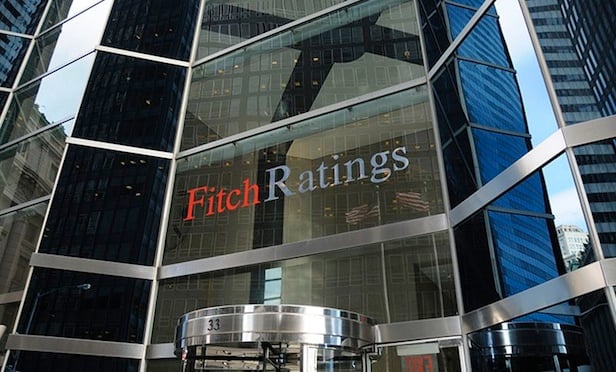
NEW YORK CITY—The so-called wave of maturities having crested in 2017, the new year bodes well for a more settled outlook on the CMBS market. Fitch Ratings cites strong new issuance volume, continued resolution activity and the slowing pace of new delinquencies all adding up to the sixth consecutive month of decline in the US CMBS delinquency rate, and predicts further declines in late-pays during 2018.
Fitch's overall US CMBS delinquency rate finished the year at 3.22%, 15 basis points lower than the previous month and 12 bps lower than a year ago, although delinquencies for the office and retail sectors were up from the year-ago period. Using a different yardstick, Trepp LLC said earlier this month that delinquencies had ended the year at 4.89%, a decline of 29 bps from November.
CMBS delinquencies as measured by Fitch ended '17 at $11.9 billion, down 2% from $12.1 billion at year-end 2016. The current delinquency rate is the lowest level seen since September '16 and the largest month-over-month decrease since January of that year, when the $3-billion securitization on the Peter Cooper Village/ Stuyvesant Town apartment complex was resolved.
Fitch said last week it expects the overall delinquency rate to end '18 between 2.25% and 2.75%. The ratings agency's expectation for the lower overall delinquency rate this year is attributed to negligible maturing loan volume, continued stable performance of 2.0 loans, similar new issuance volume from the prior year and the expectation for increased REO liquidations by special servicers.
Another factor, of course, is the increasingly small share of the overall CMBS that's represented by delinquent loans. Morningstar said last month that as of this past November, delinquencies from deals issued from 2005 through 2008 represented 87.2% of all delinquencies by balance, although legacy CMBS comprised less than 6% of the overall CMBS pie. Comparatively, delinquencies from deals issued from 2013 through 2017 contribute 11.2% of all delinquencies and represent 0.3% of the CMBS universe.
Annual private-label CMBS issuance in the years since the downturn has yet to crack the $100-billion barrier, let alone scale the heights reached in 2007, when $230.5 billion of deals were securitized. However, the third quarter of '17 saw the CMBS sector reverse a decade-long downward trend and increase its holdings by 0.8%, according to the Mortgage Bankers Association. Issuance was generally expected to finish '17 at between $85 billion and $90 billion.
The forecast for the coming year varies depending on the source. As part of its 2018 MBA CREF Outlook Survey released earlier this month, MBA said the expectation was generally for CMBS issuance to remain flat or increase, with 23% of respondents predicting increases averaging less than 5%.
For their part, ratings agencies expect issuance this year to be either flat or show a slight decline, given factors that include a considerably lower volume of maturing CMBS loans to refinance. Fitch and Kroll Bond Rating Agency both expect single-borrower activity to be strong this year, but predict that non-agency issuance overall will decline. Fitch expects a drop to $75 billion, while KBRA sees private-label volume of about $65 billion. Morningstar predicts volume between $70 billion and $75 billion, while S&P Global Ratings is somewhat more optimistic, expecting only a slight drop from '17 levels.
Want to continue reading?
Become a Free ALM Digital Reader.
Once you are an ALM Digital Member, you’ll receive:
- Breaking commercial real estate news and analysis, on-site and via our newsletters and custom alerts
- Educational webcasts, white papers, and ebooks from industry thought leaders
- Critical coverage of the property casualty insurance and financial advisory markets on our other ALM sites, PropertyCasualty360 and ThinkAdvisor
Already have an account? Sign In Now
*May exclude premium content© 2025 ALM Global, LLC, All Rights Reserved. Request academic re-use from www.copyright.com. All other uses, submit a request to [email protected]. For more information visit Asset & Logo Licensing.








